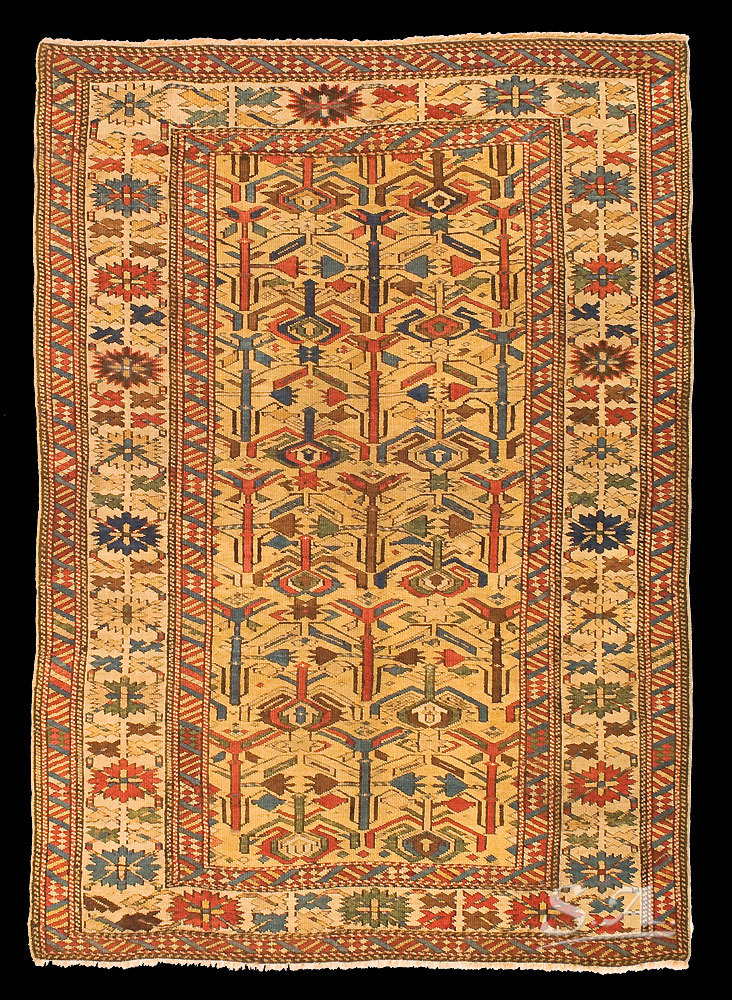|
Antique Kuba rug,
Salmasöyüd design, Southern
Kuba Region, 98 x 137 cm, North East
Azerbaijan. Said Aziz Mohammadi Tappeti Antichi
|
|
 |
Kuba rugs of this predominantly yellow-ground palmette design group are
extremely rare and highly desirable among collectors. The knotting is very
similar to the Turkoman weavings and there is some probability that it has
been woven by Turkoman people when they had moved into Kuba area in 18th
century. This supposition can be confirmed by an unusual design (but very
similar to this Kuba rugs group) of an Asmalyk Yomut in the Musée des Arts
Décoratifs in Paris.
There are only few known and published examples of this rare group around
the world:
a yellow-ground rugs with a black and white floral wine border
- Hermann, E., Von Lotto bis Tekke, no. 37 (also in Volkmann, M., Alte
Orientteppiche) - later Heinrich Kirchheim private collection;
- several authors, Antike Orientteppiche in Österreichischem Besitz, no. 58
- probably still in Austrian private collection;
- Hermann, E., Seltene Orientteppiche IX, no. 34;
- Skinner Auction House, 3 November 1983, lot 76 (later sold for 87,000 DM
at Rippon Boswell's on 28 March 1992, lot 146);
other variations
- a prayer rug with the same field design but a different border: Hermann,
E., Seltene Orientteppiche V, no. 25;
- an ivory-ground rug with only the narrow trefoil border appeared twice on
the American market in 1981 (at Sotheby's and at Edelmann's);
- an another later ivory-ground prayer rug appeared in Rippon Boswell's on
30 May 1992;
- and finally, a rather later blue-ground example, dated 1273 AH = 1857 AD,
we don't know if publicated and where.
This outstanding collector's piece comes from a private Austrian collection
and unlike the other examples of this rare Kuba rugs group has a different
design and color of the main border. In good condition.
Publ: Hali – International Magazine of Antique Carpets and Textile Art nr.
156, London, 2008
|
I tappeti Kuba con il disegno a palmette su fondo giallo sono
estremamente rari e desiderati dai collezionisti. Il nodo è molto simile a
quello dei tappeti turcomanni ed è probabile che questo esemplare è stato
annodato dalle tribù turcomanne che si sono spostate nel '700 nell'area di
Kuba. Una certa conferma di questa teoria la si trova nel inusuale disegno
(ma molto simile a questo gruppo di tappeti Kuba) di un Asmalyk Yomut nel
Museo di Arte Decorativa a Parigi.
Nel mondo esistono solo pochi esemplari conosciuti e pubblicati di questo
gruppo:
a fondo giallo con bordura bianco-nera con foglie d'uva
- Hermann, E., Von Lotto bis Tekke, nr. 37 (anche nel libro di Volkmann, M.,
Alte Orientteppiche) - più tardi collezione privata di Heinrich Kirchheim;
- vari autori, Antike Orientteppiche in Österreichischem Besitz, nr. 58 -
probabilmente ancora in una collezione privata austriaca;
- Hermann, E., Seltene Orientteppiche IX, nr. 34;
- Skinner Auction House, 3 novembre 1983, lotto 76 (più tardi venduto per
87,000 DM da Rippon Boswell, 28 marzo 1992, lotto 146);
altre variazioni
- un tappeto a preghiera con lo stesso disegno del campo ma con una bordura
differente: Hermann, E., Seltene Orientteppiche V, nr. 25;
- un tappeto a fondo color avorio e una stretta bordura a trifoglio è
apparso due volte sul mercato americano nel 1981 (da Sotheby's e da
Edelmann's);
- un altro tappeto a preghiera piuttosto tardo con il fondo color avorio c'è
stato da Rippon Boswell il 30 maggio 1992;
- e per finire un tappeto piuttosto tardo a fondo blu, datato 1273 Anno
Hedjra = 1857 AD non sapiamo se pubblicato e dove.
Questo straordinario pezzo da collezionismo arriva da una collezione privata
austriaca e rispetto ad altri esemplari di questo raro gruppo di Kuba ha un
differente disegno e colore della bordura principale. In buon stato di
conservazione.
Pubbl: rivista Hali – International Magazine of Antique Carpets and Textile
Art nr. 156, Londra, 2008 |
